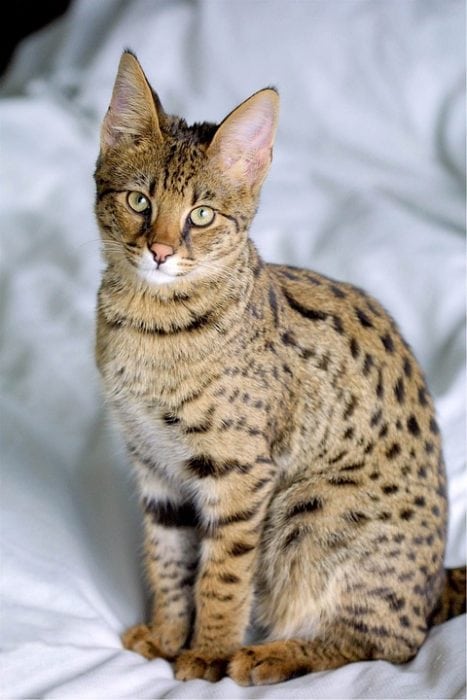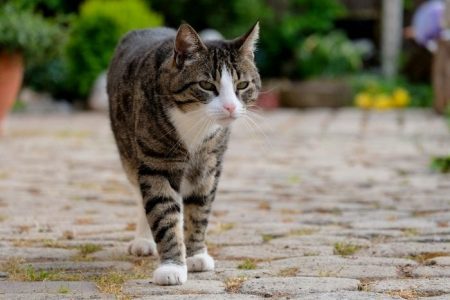
The Savannah cat is an incredible animal that is a mixture of a domesticated cat and a wild cat. Lithe and graceful, decorated with the exotic markings of a wild cat, the Savannah cat is nevertheless quite at home stalking the streets of suburbia.
This sleek feline has all of the street smarts of a stray cat along with the natural sophistication of a pampered house cat. While the Savannah cat is the size of a large domestic cat, the large ears and long rangy legs of the Savannah cat make it a distinct and striking family pet.
What is a Savannah Cat?
A Savannah cat is actually a hybrid breed of cat. The breed is a mix of the Serval cat, a wild cat that is native to Africa, and the domestic cat. Officially registered as a recognized cat breed by the International Cat Association (TICA) in 2001, the Savannah cat was first born in the 1980s when a female domestic cat and a male Serval cat produced kittens. As of 2012, the Savannah cat has been accepted for championship breed status by TICA.

Domestic cat. Image source: Pixabay.
Many of the striking features of the Savannah cat come from the exotic wild Serval cat, but in further developing the Savannah cat breed, some of the more exotic domestic cats have been brought in to the family line. The original Savannah cat was born of a female Siamese cat, although the Abyssinian, the Oriental Shorthair, or the Egyptian Mau breeds have been mixed in as well as other breeds of cats. Such out-crossings are no longer permissible by TICA due to the championship status of the Savannah cat, and only Savannah to Savannah crossings are acceptable.
What is a Serval Cat?
Native to sub-Saharan countries in Africa, the Serval is a wild cat that prefers to hunt in savannahs with plenty of tall grass for cover. The long legs, large ears, and spotted coat are characteristics of the Serval cat that are reflected in their Savannah cat offspring.
Generations of Savannah Cats
The generations of Savannah cats each have a filial number, marked by a capital F followed by the generation number. The first generation of Savannah cats is marked as F1 and is fifty percent Serval cat and fifty percent domestic cat. Savannah cats that are born of an F1 female and full Serval cat male are known as BC1, or backcross 1, and are seventy-five percent Serval cat. These BC1 Savannah cats are also sometimes called F1 Savannah cats. The F2 generation is born of an F1 female and has a Serval cat grandparent.
What is the Typical Lifespan of a Savannah Cat?
Like domestic cats, Savannah cats can live up to twenty years, although fifteen years is a more common lifespan for the cats. When kept in captivity, Serval cats can live for up to twenty years as well, although when living in the wild, they tend to live for ten years on average.
What are the Classic Characteristics of a Savannah Cat?
Because the Savannah cat is a hybrid, the markings on its coat are distinctive and reminiscent of the marking of the Serval cats. As the Savannah cat is now officially able to take part in TICA championship contests for the breed, the only allowed markings on its coat are spots, because those are the only markings found on the coat of a Serval cat. However, Savannah cats may also have marbled or Rosetted markings. They may also have point colorings, where the body is lighter in color and extremities such as the ears, feet, and tail are darker in color.
The standard coloring of the breed as recognized by TICA is limited to brown-spotted, silver-spotted, black, or black smoke. The brown-spotted may be brown, tan, or gold and have black or dark brown spots. The silver-spotted may be silvery colored with black or dark gray spots. The black may be black with black spots, and the black smoke may be silver with black tips and black spots. Other colorings for the Savannah cat exist, including blue, lilac or lavender, cinnamon, or chocolate.
Some classic characteristics of Savannah cats include their ears, which resemble those of the Serval cat. The ears of the Savannah cat are large, with broad bases and rounded tips. The backs of the ears often have ocelli markings, which are the alternating dark and light colored bands.
The heads of Savannah cats tend to be triangular in shape, and are on the smaller side, as are their tails. Their tails tend to have a black or dark colored tip and rings along the length of the tail. Savannah cats have heavy brows to help shade their eyes from sunlight, much like Serval cats. Savannah cats also often have ‘tear-marks’ running from the corners of their eyes down the sides of their faces.
While they possess the long legs of the Serval cat, Savannah cats tend to be approximately the same size as domestic cats. They can be slightly taller and may weigh more (they can weight anywhere from eight to thirty pounds). Savannah cats tend to be slim and rangy with the long legs inherited from their Serval family members.
What is the Temperament of a Savannah Cat?
Savannah cats are highly intelligent cats. They are able to figure out how to open doors or cupboards, or to turn on alarm clocks to gain attention. They like to play tricks or hide and play tag with their humans.
They are curious animals and like to explore. They like to climb and survey the world from high locations. Able to jump to a height of eight feet up, and will likely lurk on counters, the top of the fridge, or on top of cabinets.
Likely inherited from their wild Serval cat family members, Savannah cats are full of energy. They enjoy the water and may try to take a swim in your bath or to splash around in a toilet when the lid is left up. They aren’t likely to spend a lot of time laying around or being petted for hours on end. Rather, Savannah cats would prefer to go for a walk and can easily be trained to walk with a harness and leash like a dog, and can even be trained to play fetch. Also like a dog, Savannah cats can be fiercely loyal to their humans and wary of strangers.
Savannah cats make a range of noises that can differ from the sounds typically produced by domestic cats. They can meow, but they may also chirp like Serval cats, or even mix the two noises. Savannah cats also hiss like domestic cats, but the hissing sound produced by the Savannah cat is more like that of the Serval cat and is louder than the hiss of a domestic cat. The hissing can sound like an angry snake and may startle some.
The generation of the Savannah cat will influence the behavior that the cat displays, but the level of socialization and general upbringing will also impact the temperament of the Savannah cat.
With an aspect of the larger size as well as the exotic nature and grace of a wild cat, but the friendliness and charm of a domestic cat, the Savannah cat makes a wonderful addition to the family. Elegantly wild and yet safe and loving, the Savannah cat is an active and intelligent pet that requires attention that is no hardship to supply. With the life expectancy of a typical domestic cat, the Savannah cat will provide many years of love and companionship.









